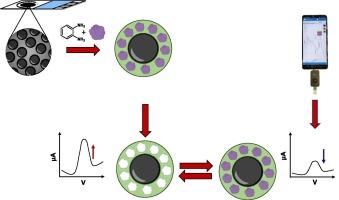丝网印刷碳电极上的电聚合 InZnSe@PtAg 量子点@分子印迹聚合物用于基于智能手机的唾液中登革热病毒 NS1 蛋白的超灵敏检测
IF 4.9
2区 化学
Q1 CHEMISTRY, ANALYTICAL
引用次数: 0
摘要
据世界卫生组织(WHO)估计,每年登革热病毒(DENV)感染病例约为 1 亿至 4 亿例,全球有一半人口面临感染风险。目前,还没有已知的治疗登革热病毒的方法;然而,早期、快速和准确(灵敏和选择性)的检测有助于降低死亡率。这项研究报告了利用纳米结构的 InZnSe@PtAg量子点(QDs)-分子印迹聚合物(MIP)和基于智能手机的检测功能,针对 DENV 开发的新型护理点电化学生物传感器。在金属前体、有机表面活性剂和配体的存在下,新合成了高导电性 InZnSe@PtAg QDs,并利用配体交换反应在其表面封端了谷胱甘肽(GSH)。PtAg 用作 InZnSe QDs 核心表面的电活性外壳层,以增加 QDs 的导电性。将 GSH-InZnSe@PtAg QDs 滴铸到丝网印刷碳电极(SPCE)上,并在邻苯二胺和模板 DENV 存在下使用循环伏安法(CV)进行电聚合。稳健的电聚合过程允许在 QDs/SPCE 上覆盖 MIP 层,并在该层上形成特定尺寸和形状的 DENV 空穴。在最佳实验条件下,可快速、选择性和超灵敏地检测 DENV。利用差分脉冲伏安法(DPV),DENV 在 MIP@QDs/SPCE 表面的定量再结合导致阳极峰电流稳步下降,DENV 检测的检测限为 1.36 pg/mL。利用基于智能手机的手持式恒电位仪,成功地检测了人体唾液中的 DENV,分析回收率令人满意。本文章由计算机程序翻译,如有差异,请以英文原文为准。

Electropolymerized InZnSe@PtAg quantum dots@molecularly imprinted polymer on screen-printed carbon electrodes for the ultrasensitive detection of NS1 dengue virus protein with smartphone-based sensing in saliva
According to the World Health Organization (WHO), an estimated 100–400 million cases of dengue virus (DENV) infections are recorded annually with half of the global population being at risk of infection. Currently, there is no known treatment for DENV; however, early, rapid and accurate (sensitive and selective) detection can help to alleviate fatality rates. This work reports on the novel development of a point-of-care electrochemical biosensor for DENV using nanostructured InZnSe@PtAg quantum dots (QDs)-molecularly imprinted polymer (MIP) with smartphone-based detection functionality. Highly conductive InZnSe@PtAg QDs were newly synthesized in the presence of metal precursors, organic surfactants and ligands and surface capped with glutathione (GSH) using a ligand exchange reaction. PtAg was used as an electroactive shell layer on the InZnSe QDs core surface to increase the QDs conductivity. The GSH-InZnSe@PtAg QDs were drop-casted onto screen-printed carbon electrodes (SPCEs) and electropolymerized using cyclic voltammetry (CV) in the presence of o-phenylenediamine and the template DENV. The robust electropolymerization process allowed the overcoating of the MIP layer on the QDs/SPCE, where specific DENV size and shape cavities were created. Under optimal experimental conditions, DENV was rapidly, selectively and ultra-sensitively detected. Using differential pulse voltammetry (DPV), quantitative rebinding of DENV on the MIP@QDs/SPCE surface led to a steady decrease of the anodic peak current and a limit of detection of 1.36 pg/mL was obtained for DENV detection. Using a hand-held smartphone-based potentiostat, DENV was successfully detected in human saliva with satisfactory analytic recoveries.
求助全文
通过发布文献求助,成功后即可免费获取论文全文。
去求助
来源期刊

Microchemical Journal
化学-分析化学
CiteScore
8.70
自引率
8.30%
发文量
1131
审稿时长
1.9 months
期刊介绍:
The Microchemical Journal is a peer reviewed journal devoted to all aspects and phases of analytical chemistry and chemical analysis. The Microchemical Journal publishes articles which are at the forefront of modern analytical chemistry and cover innovations in the techniques to the finest possible limits. This includes fundamental aspects, instrumentation, new developments, innovative and novel methods and applications including environmental and clinical field.
Traditional classical analytical methods such as spectrophotometry and titrimetry as well as established instrumentation methods such as flame and graphite furnace atomic absorption spectrometry, gas chromatography, and modified glassy or carbon electrode electrochemical methods will be considered, provided they show significant improvements and novelty compared to the established methods.
 求助内容:
求助内容: 应助结果提醒方式:
应助结果提醒方式:


